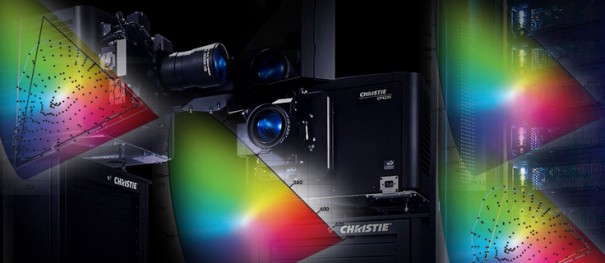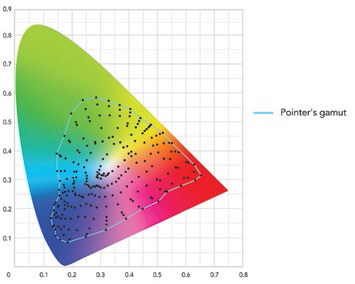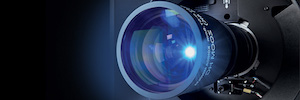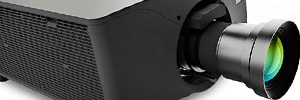RGB Laser Projection: How to Turn Rec. 2020 Color into a Reality
Color Rec. 2020 gives us the opportunity to show a better representation of real-world colors than the color spaces typically used in television and film. In practice, the achievement of these primaries is not limited to single wavelengths, and can be achieved with a “package” of wavelengths. Laser lighting projectors are the perfect solution to achieve this, says Marcos Fernández, director of Christie for Spain and Portugal, in this interesting Tribune.
In 2012, the International Telecommunication Union (ITU) published Recommendation ITU-R BT.2020 (Rec. 2020) for the use of ultra-high definition television (UHDTV) image systems. The recommendation addresses the parameters of next-generation television display systems, and includes advice regarding high definition, high frame rates, and improved color performance. The world of moving images is now studying extending the color range of Rec. 2020 to cinema, and is showing special interest in the opportunity of incorporating laser projection technology into this task. In this technical report we will stop to analyze what the Rec. 2020 recommendation entails, the need to expand the color and the challenges that we will have to overcome in practice to achieve it.
Color scientists at the International Commission on the Illumination (CIE) established a numerical definition for each of the colors we perceive, based on the eye's sensitivity to color. These colors are represented in the color space diagram associated with the CIE 1931 standard. In it, each color is associated (exclusively for it) with a pair of coordinates (x,y), with the luminance or brightness of the color represented as a separate value.
The representation of color (x,y) forms the basis of conventional color science, and we draw on it to understand current representations of color space and their limitations, as well as the opportunity to display richer images that arises from improved in color performance.
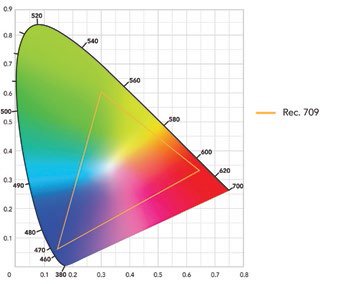 Color display and display: how do we reproduce it?
Color display and display: how do we reproduce it?
In today's era of digital projection, it is common to reproduce color by combining the primary colors red, green and blue. The desired colors are achieved by proportionally mixing those primaries. Color science allows us to determine the global chromatic capacity of a display by plotting the chromaticity coordinates (x,y) of each of the primary colors in the CIE diagram and drawing a triangle over them. The triangle defines the “color range” of the display.
All colors within the triangle are reproducible; The opposite will happen with those who are left out. For example, the current color gamut is defined by the Rec. 709 standard and results in the spectrum shown in this diagram.
An obvious consideration when choosing a color palette is its ability to display real-world colors. Although the CIE 1931 standard covers all visible colors, it does not tell us which colors are common in everyday life. In 1980 Dr. Michael Pointer published a real-world color repertoire, often cited as representative of the range of naturally occurring reflective colors. The result is the irregular range of colors represented in this figure.
But in addition to the reflective colors present in the real world, there are emitting colors, such as neon signs, LED brake lights on cars, or lightsabers. These are very saturated colors and most of them are outside the color set of Pointer's chromatic selection.
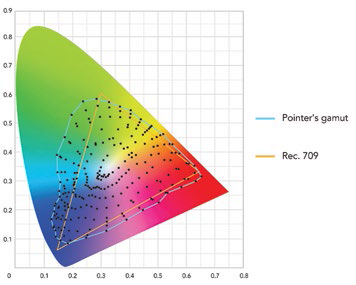 Comparison between color standards and real-world colors
Comparison between color standards and real-world colors
By comparing any color range to Pointer's real-world color range we can determine how closely they represent them. In this figure we see the Pointer color set and the color gamut corresponding to the current high-definition television standard (Rec. 709). We clearly see that there are a series of colors that the current standard is unable to reproduce. Among the colors that we miss, there are some that are important from a visual point of view. This is the case, in particular, of the yellow and gold zone (skin tones) and the cyan and blue zone (tropical sky and waters).
The wide color gamut Rec. 2020: what it is and how it compares to the DCI P3 cinema standard
The Rec. 2020 standard covers an increased color gamut that was developed in an attempt to capture real-world colors in a three-primary system. The committee in charge of setting the standards for Rec. 2020 chose primary color coordinates located at the extreme edge of the visible color space. Those color primaries are feasible with RGB laser lighting projection technologies.
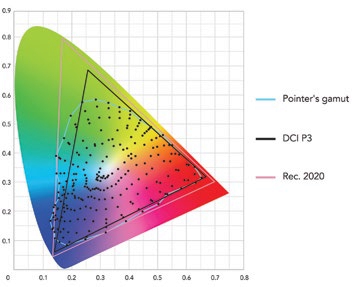 This figure shows the Rec. 2020 gamut overlaid on the CIE 1931 color space diagram, and also (for reference) the Pointer colors and the DCI P3 cinema color gamut.
This figure shows the Rec. 2020 gamut overlaid on the CIE 1931 color space diagram, and also (for reference) the Pointer colors and the DCI P3 cinema color gamut.
Although the digital cinema color space more effectively captures the Pointer color range, it excludes a number of colors, primarily in the cyan region. As we see in the illustration, practically all the colors that are left out are captured by the Rec. 2020 color gamut.
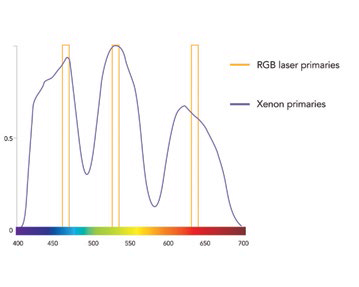 How does laser projection achieve the Rec. 2020 color gamut?
How does laser projection achieve the Rec. 2020 color gamut?
Rec. 2020 places its primaries at the spectral locus, that is, to achieve chromaticity at the primary point, the primary must have a very narrow bandwidth. For practical reasons, it is desirable to mix some of the nearby wavelengths to achieve the color primary, which would theoretically remove the chromaticity from the spectral locus. That said, in practice mixing a few wavelengths will be enough to achieve the chromaticity goal within reasonable measurement accuracy. RGB laser projectors, such as the Christie 3P RGB laser projection system, feature wavelengths that have been chosen to optimize the deployment of Rec. 2020 color primaries and achieve the full Rec. 2020 color gamut, thus ensuring the Enjoy a full color experience.
Marcos Fernandez
Director of Christie for Spain and Portugal
Did you like this article?
Subscribe to our RSS feed and you won't miss anything.



